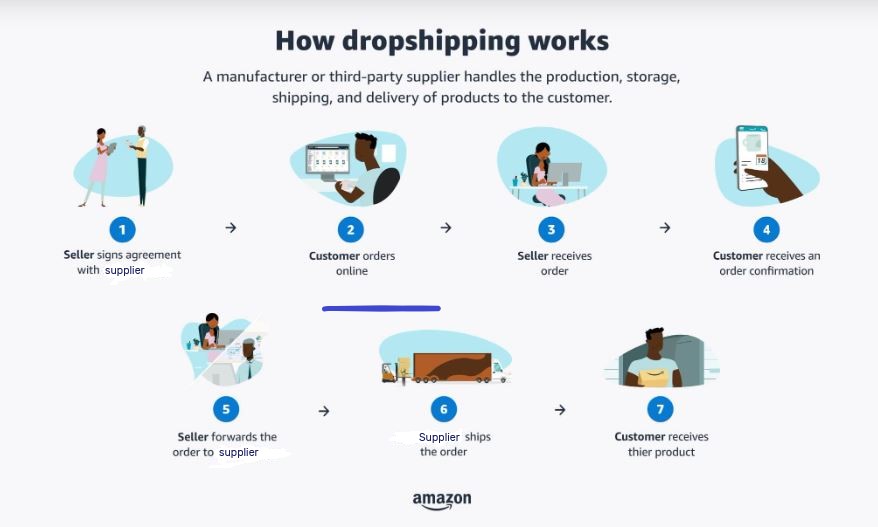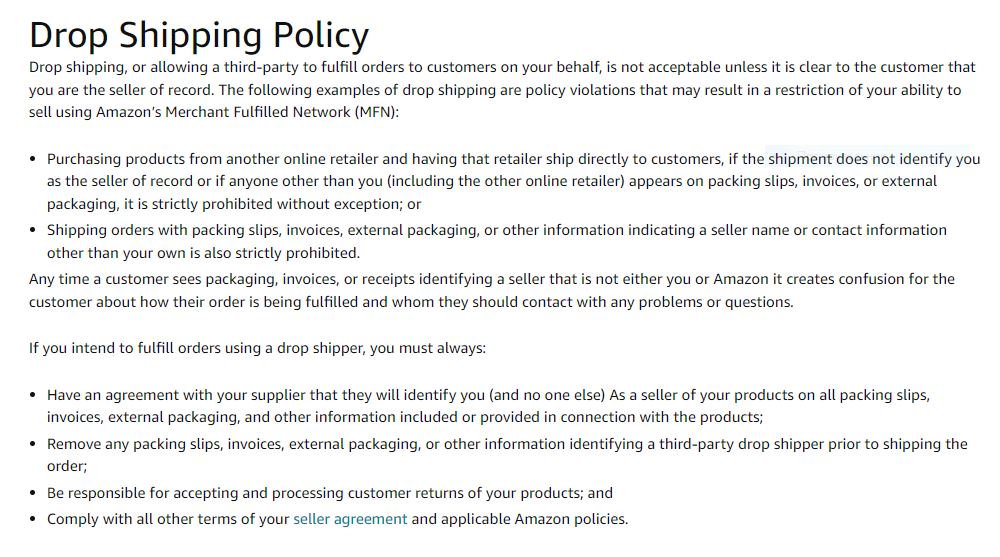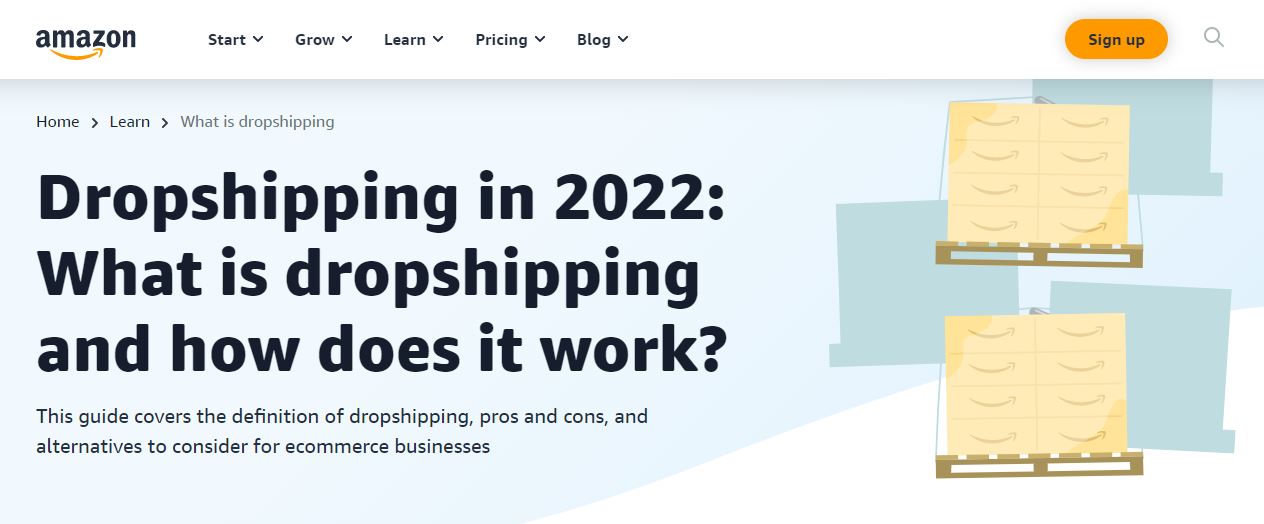Table of Contents
A lot of people think about launching a business on Amazon. Yet not all of them have a lot of money to invest upfront. If this is your case, then most likely Amazon drop shipping is a solution for you.
A lot of successful merchants who managed to build up a 7-figure Amazon business started as drop shippers. This is a good opportunity to shoot your first products on the marketplace. There are two reasons behind it. Firstly, it’s fairly easy to set up dropshipping on Amazon. Secondly, you need very little funds to begin selling.
As a matter of fact, dropshipping is quite a straightforward business model. You list a product on Amazon and wait for a shopper to buy it. When they purchase the item, you ask a product supplier to ship it to the customer. However, not everything is as simple as it seems.
Read more to find out how to start dropshipping on Amazon and tips about how to dropship on Amazon.
What Is Amazon Dropshipping?
Dropshipping is a reselling business model where a merchant doesn’t stock inventory. When a buyer orders a product, a drop shipper purchases it from a supplier. The supplier, typically a manufacturer or a distributor, delivers the product to the end customer.
Therefore, the most essential distinction between dropshipping Amazon and other retail sales models is that the drop shipper doesn’t own and stock any inventory.
In such a model, the drop shipper plays a role of a middleman. They get a profit margin from the difference between a wholesale manufacturer’s price and a retail price on Amazon.
How does dropshipping on Amazon work?
As said, Amazon dropshipping process typically includes several straightforward steps.
Amazon drop shipping step by step
Step 1. Seller finds a product in demand.
Step 2. Seller signs agreement with the supplier.
Step 3. Seller lists a product on Amazon.
Step 4. An Amazon shopper purchases a product online.
Step 5. The seller gets the order.
Step 6. The shopper receives the order confirmation.
Step 7. The seller forwards the order to the supplier.
Step 8. Supplier ships the order to the shopper.
Step 9. The shopper obtains a product.

Amazon dropshipping step by step
Amazon drop shipping policy
The general idea behind Amazon’s drop shipping policy is that an Amazon merchant, and not a third-party supplier, is identified as the seller of a product. Imagine that a buyer who has purchased an item on Amazon receives a product that a drop shipper ordered from Home Depot or Walmart. They will be upset and confused since they expect Amazon shipment and obtain the parcel from another retailer.
Therefore, Amazon doesn’t allow you to deliver to the customers third-party goods unless it is clear that you are the seller of record. For example, you can’t purchase a drywall screwdriver from Home Depot and have them ship it directly to your buyer if packing slips, invoices, or external packaging identifies Home Depot as a retailer. According to Amazon’s regulations, all of that should be removed.
According to Amazon, all information indicating a seller’s name or contact information should refer to you, not to other manufacturers or retailers. That’s why you should have an agreement with the supplier that they package your inventory accordingly.

Amazon Drop Shipping policy
Dropshipping regulations on Amazon:
- All order information (shipping orders with packing slips, invoices, external packaging), must refer to you as the product seller;
- Remove any third-party information before shipping;
- Take responsibility for accepting and processing customer returns;
- Conclude agreements with your Amazon dropshipping suppliers to ensure that they will identify you as a product seller;
- Comply with all Amazon Terms of Service.
Amazon warns, that if you violate the provisions of the Drop Shipping Policy, this may negatively influence your account health and even lead to suspension.
Dropshipping vs Retail Arbitrage, Private Labeling, and Wholesaling
Compared to other sales models on Amazon, dropshipping is easy to launch and requires a low initial investment. However, profit margins are thinner and there is a high risk of a ban from Amazon’s side.
Dropshipping vs private labeling
Private labeling is a model when you find a product in demand and create your own brand out of it, for instance, by introducing certain improvements. This is a long way to go compared to dropshipping since you need to produce the inventory. On the other hand, as far as your product is unique, you can get a better profit margin and have less competition.
Dropshipping vs retail arbitrage
Arbitrage is when a seller purchases discounted products from retail stores or websites and resell them on Amazon. Both models are easy to start.
Compared to dropshipping, retail arbitrage allows for more control over order fulfillment. On the other hand, drop shipper doesn’t have to store inventory. A retail arbitrage seller can have an Amazon store and fulfill the inventory using FBA instead, but the service comes with a cost.
In addition, if a drop shipper finds a profitable product from a retailer like Walmart, they may not be able to sell it due to Amazon’s dropshipping restrictions we discussed above. In such a case, they can go ahead with retail arbitrage.
Dropshipping vs wholesaling
Wholesalers purchase huge volumes of inventory from manufacturers hence big discounts. Not only do they physically own their inventory, but drop shippers don’t. Wholesalers also have to put a lot of money upfront into buying goods. At the same time, the drop shipper’s initial investment is very low. However, the wholesaler’s business is more consistent and profit margins are higher.

Amazon dropshipping guide page
Pros and Cons of Dropshipping
In point of fact, the clear advantage of dropshipping is a fast startup and very low upfront cost. You even don’t need a website or store. Thus, you can begin selling on Amazon more or less immediately. The same refers to the product ideas. You can select any profitable product, agree with the supplier and launch it.
Nevertheless, one of the big disadvantages of this model is that you have very little control over fulfillment. Should anything go wrong with the shipment, you can’t do much about it. On top of that, Amazon has very stringent dropshipping regulations hence the risk of an account ban.
Advantages of dropshipping
Low startup cost
If you don’t have the initial capital to invest in Amazon, dropshipping is a good way to start a business. With this model, you don’t have any starting and overhead costs. You don’t have to purchase and fulfill the inventory, as well as process orders. You don’t have to have a website either.
Fast launch
A merchant can start selling a dropshipping product as soon as they made product research, found a product, and agreed with the supplier. they don’t even need to wait for the delivery. Also, they don’t have to think about operating location and can work from anywhere.
Easy product ideas
Unlike merchants who sell private label products, drop shippers don’t necessarily sell unique products. They can focus on the items that pre-exist on Amazon. For instance, you can pay close attention to products that have a high sales rank, or profitable product categories with moderate competition. Also, look into the items that don’t have too many reviews.
Scalability
A lot of sellers on Amazon have started their big businesses with drop shipping. This model allows for growing sales without investing in stocking and order processing.
Full automation
With different tools and apps, you can try and automate the majority of sales processes. For instance, SellerSonar’s Amazon notifications help you automatically monitor product price changes, Buybox hijackers, new and deleted reviews, inventory suppressions, and more.
Limitations of Dropshipping
High Competition
As far as any seller can start dropshipping business quite easily, the competition is fairly high. On top of that, the majority of drop shippers sell pre-existing products on Amazon, which makes the rivalry even tougher.
Low margins
For the same reason, dropshipping doesn’t give you a lot of room for maneuver when it comes to increasing the price. On top of that, your competitors use more or less the same repricing tools to adjust the price. In addition, since your product is not unique, you can’t add on a lot.
Almost no fulfillment control
Given that drop shippers don’t deal with inventory fulfillment, they can’t influence the time and process of shipping. In this game, the ball is on the supplier’s field. In case of any delays or other problems, there’s not much you can do.
No quality monitoring
Not being involved in the fulfillment process gives the seller no chance to check the level of product quality and its condition. In this, you should rely on the supplier.
Risk of ban
As said, Amazon has a very strict dropshipping policy. If your supplier fails to observe Amazon’s regulations, as the case may be, Amazon can suspend or even ban your listing. On top of that, there is a risk of suspension due to an inventory glitch or late shipments.
How to Start Dropshipping on Amazon?
The basic steps of starting an Amazon business are very similar to all sales models. The difference is in the ways of product research, methods of looking for suppliers, and approaches to listing the product.
Key Steps to Starting Dropshipping Business
Step 1. Create an Amazon seller account;
Step 2. Make product research;
Step 3. Find a supplier and conclude an agreement;
Step 4. List a product on Amazon;
Step 5. Start selling.
To be successful in your dropshipping business, you should be instantly aware of how your products are behaving. Be assured, that your competitors do.
Monitoring software is an efficient way to stay on top of your sales. SellerSonar offers instant Amazon alerts to protect your sales. With us, you are aware of all listing changes, Buybox hijackers, new/deleted reviews, keyword rank history, and product suppressions.
Try SellerSonar now. Register for our 29-day trial and boost your incredible journey of running your business on the platform.

